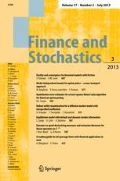Abstract
Under short-sales prohibitions, no free lunch with vanishing risk (NFLVRS) is known to be equivalent to the existence of an equivalent supermartingale measure for the price process (Pulido in Ann. Appl. Probab. 24:54–75, 2014). We give a necessary condition for the drift of a price process to satisfy NFLVRS. For two given price processes, we introduce the concept of fundamental supermartingale measure, and when a certain condition necessary for the construction of this fundamental supermartingale measure is not fulfilled, we provide the corresponding arbitrage portfolios. The motivation of our study lies in understanding the particular case of converging prices, i.e., two prices that coincide at a bounded random time.
Similar content being viewed by others
References
Ansel, J.-P., Stricker, C.: Lois de martingale, densités et décomposition de Föllmer Schweizer. Ann. IHP, Phys. Théor. 28, 375–392 (1992)
Back, K.: Asset pricing for general processes. J. Math. Econ. 20, 371–395 (1991)
Bain, A., Crisan, D.: Fundamentals in Stochastic Filtering. Springer, New York (2009)
Brémaud, P., Yor, M.: Changes of filtration and of probability measures. Z. Wahrscheinlichkeitstheor. Verw. Geb. 45, 269–295 (1978)
Choulli, T., Stricker, C.: Deux applications de la décomposition de Galtchouk–Kunita–Watanabe. In: Azéma, J., et al. (eds.) Séminaire de Probabilités XXX. Lecture Notes in Mathematics, vol. 1626, pp. 12–23. Springer, Berlin (1996)
Delbaen, F., Schachermayer, W.: A general version of the fundamental theorem of asset pricing. Math. Ann. 300, 463–520 (1994)
Delbaen, F., Schachermayer, W.: The existence of absolutely continuous local martingale measures. Ann. Appl. Probab. 5, 926–945 (1995)
Delbaen, F., Schachermayer, W.: The fundamental theorem of asset pricing for unbounded stochastic processes. Math. Ann. 312, 215–250 (1998)
Dellacherie, C., Meyer, P.-A.: Probabilities and Potential B: Theory of Martingales. North-Holland Publishing Company, Amsterdam–New York–Oxford (1980)
Elliott, R.J., Jeanblanc, M., Yor, M.: On models of default risk. Math. Finance 10, 179–196 (2000)
Föllmer, H., Schweizer, M.: Hedging of contingent claims under incomplete information. In: Davis, M.H.A., Elliott, R.J. (eds.) Applied Stochastic Analysis, Stochastics Monographs, vol. 5, pp. 389–414. Gordon and Breach, London (1991)
Frittelli, M.: Semimartingales and asset pricing under constraints. In: Dempster, M.A.H., Pliska, S.R. (eds.) Mathematics of Derivative Securities. Publications of the Newton Institute, vol. 15, pp. 265–277. Cambridge Univ. Press, Cambridge (1995)
He, S., Wang, J., Yan, J.: Semimartingale Theory and Stochastic Calculus (1992). Science Press, CRC Press
Jacod, J., Shiryaev, A.N.: Limit Theorems for Stochastic Processes, 2nd edn. Springer, Berlin (2003)
Jarrow, R., Protter, P., Pulido, S.: The effect of trading futures on short sale constraints. Math. Finance 25, 311–338 (2015)
Jouini, E., Kallal, H.: Arbitrage in securities markets with short-sales constraints. Math. Finance 5, 197–232 (1995)
Karatzas, I., Kardaras, C.: The numéraire portfolio in semimartingale financial models. Finance Stoch. 11, 447–493 (2007)
Napp, C.: The Dalang–Morton–Willinger theorem under cone constraints. J. Math. Econ. 39, 111–126 (2003)
Nikeghbali, A.: An essay on the general theory of stochastic processes. Probab. Surv. 3, 345–412 (2006)
Pham, H., Touzi, N.: The fundamental theorem of asset pricing with cone constraints. J. Math. Econ. 31, 265–279 (1999)
Pulido, S.: The fundamental theorem of asset pricing, the hedging problem and maximal claims in financial markets with short sales prohibitions. Ann. Appl. Probab. 24, 54–75 (2014)
Schweizer, M.: Martingale densities for general asset prices. J. Math. Econ. 21, 363–378 (1992)
Schweizer, M.: On the minimal martingale measure and the Föllmer–Schweizer decomposition. Stoch. Anal. Appl. 13, 573–599 (1995)
Acknowledgements
We are very indebted to Martin Schweizer and two anonymous referees for the careful reading and many suggestions that helped improve our paper.
Author information
Authors and Affiliations
Corresponding author
Additional information
Publisher’s Note
Springer Nature remains neutral with regard to jurisdictional claims in published maps and institutional affiliations.
The research of Monique Jeanblanc is supported by Chair Markets in Transition (Fédération Bancaire Française) and Labex ANR 11-LABX-0019.
Appendix A: Some recalls on measures and increasing processes
Appendix A: Some recalls on measures and increasing processes
For the reader’s convenience, we gather here some elementary results that are used in the paper.
Theorem A.1
Let\(\mu ^{1}\)and\(\mu ^{2}\)be two finite (possibly signed) measures.
(a) Assume that both\(\mu ^{1}\)and\(\mu ^{2}\)are positive measures. Then\(\mu ^{1}-\mu ^{2}\)is a positive measure only if\(\mu ^{2}\)is absolutely continuous with respect to\(\mu ^{1}\).
(b) Assume that\(\mu ^{1}\)is singular with respect to\(\mu ^{2}\)and furthermore\(\mu ^{1}+\mu ^{2}\)is a positive measure. Then both\(\mu ^{1}\)and\(\mu ^{2}\)are positive measures.
Given a filtered probability space, we call an increasing process a process that is positive, adapted and whose paths are increasing and càdlàg. A process which can be written as the difference of two increasing processes is called a process of finite variation.
An increasing process can be seen as a random measure \(dA_{t} (\omega )\) on \(\mathbb{R}_{+}\) whose distribution function is \(A_{\cdot }( \omega )\). Similarly, a process of finite variation can be seen as a signed random measure, since it can be written as the difference of two increasing processes.
Proposition A.2
([14, Proposition 3.13])Let\(A\), \(B\)be finite variation processes (resp. increasing processes) such that\(dB\ll dA\). Then there exists an optional (resp. positive) process\(H\)such that\(B=\int HdA\)up to an evanescent set. If moreover\(A\)and\(B\)are predictable, one may choose\(H\)to be predictable.
Proposition A.3
([7])
Let\(A\), \(B\)be càdlàg, predictable processes of finite variation, with\(B\)being increasing. Then there exist a predictable process\(\varphi \)and a predictable subset\(N\)of\(\Omega \times \mathbb{R}_{+}\)such that
and
Rights and permissions
About this article
Cite this article
Coculescu, D., Jeanblanc, M. Some no-arbitrage rules under short-sales constraints, and applications to converging asset prices. Finance Stoch 23, 397–421 (2019). https://doi.org/10.1007/s00780-019-00386-3
Received:
Accepted:
Published:
Issue Date:
DOI: https://doi.org/10.1007/s00780-019-00386-3
Keywords
- Equivalent supermartingale measures
- No free lunch with vanishing risk
- Short-sales constraints
- Converging asset prices



